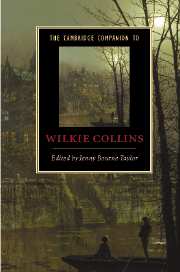Book contents
- Frontmatter
- Introduction
- 1 Collins’s career and the visual arts
- 2 The early writing
- 3 Collins’s shorter fiction
- 4 Collins and the sensation novel
- 5 The Moonstone, detective fiction and forensic science
- 6 The later novels
- 7 The professional writer and the literary marketplace
- 8 The marriage plot and its alternatives
- 9 Collins and Victorian masculinity
- 10 Collins and empire
- 11 Disability and difference
- 12 Collins and the theatre
- 13 The afterlife of Wilkie Collins
- Further reading
- Index
- Series List
4 - Collins and the sensation novel
Published online by Cambridge University Press: 28 January 2007
- Frontmatter
- Introduction
- 1 Collins’s career and the visual arts
- 2 The early writing
- 3 Collins’s shorter fiction
- 4 Collins and the sensation novel
- 5 The Moonstone, detective fiction and forensic science
- 6 The later novels
- 7 The professional writer and the literary marketplace
- 8 The marriage plot and its alternatives
- 9 Collins and Victorian masculinity
- 10 Collins and empire
- 11 Disability and difference
- 12 Collins and the theatre
- 13 The afterlife of Wilkie Collins
- Further reading
- Index
- Series List
Summary
[I]t is only natural that art and literature should, in an age which has turned out to one of events, attempt a kindred depth of effect and shock of incident . . . Sir Walter [Scott] himself never deprived his readers of their lawful rest to a greater extent with one novel than Mr Wilkie Collins has succeeded in doing with his ‘Woman in White’.
– Margaret Oliphant, ‘Sensation Novels’The serialisation of The Woman in White in Charles Dickens's new weekly magazine, All the Year Round, between 26 November 1859 and 25 August 1860 has been heralded as the birth of the sensation novel, a fictional phenomenon that has been particularly associated with the 1860s. But what exactly was the sensation novel? Did Wilkie Collins and his contemporaries - such as Mary Elizabeth Braddon, Mrs Henry Wood, Charles Reade, Rhoda Broughton, 'Ouida' (Marie Louise De la Ramée) and Charlotte Riddell - consciously think of themselves as sensation novelists? Was the sensation novel actually a distinct genre or subgenre, or was it rather a label applied to a range of novels by certain kinds of reviewer to express and amplify a particular kind of cultural anxiety? This chapter begins by addressing some of these questions before going on to look at Collins as a sensation novelist, focusing on The Woman in White and No Name (1862).
At the end of the decade that had been dominated by sensations and sensationalism of one kind or another, Thomas Hardy characterised the sensation narrative as 'a long and intricately inwrought chain of circumstance', which usually involved 'murder, blackmail, illegitimacy, impersonation, eavesdropping, multiple secrets, a suggestion of bigamy, amateur and professional detectives'.
- Type
- Chapter
- Information
- The Cambridge Companion to Wilkie Collins , pp. 50 - 64Publisher: Cambridge University PressPrint publication year: 2006
- 10
- Cited by

